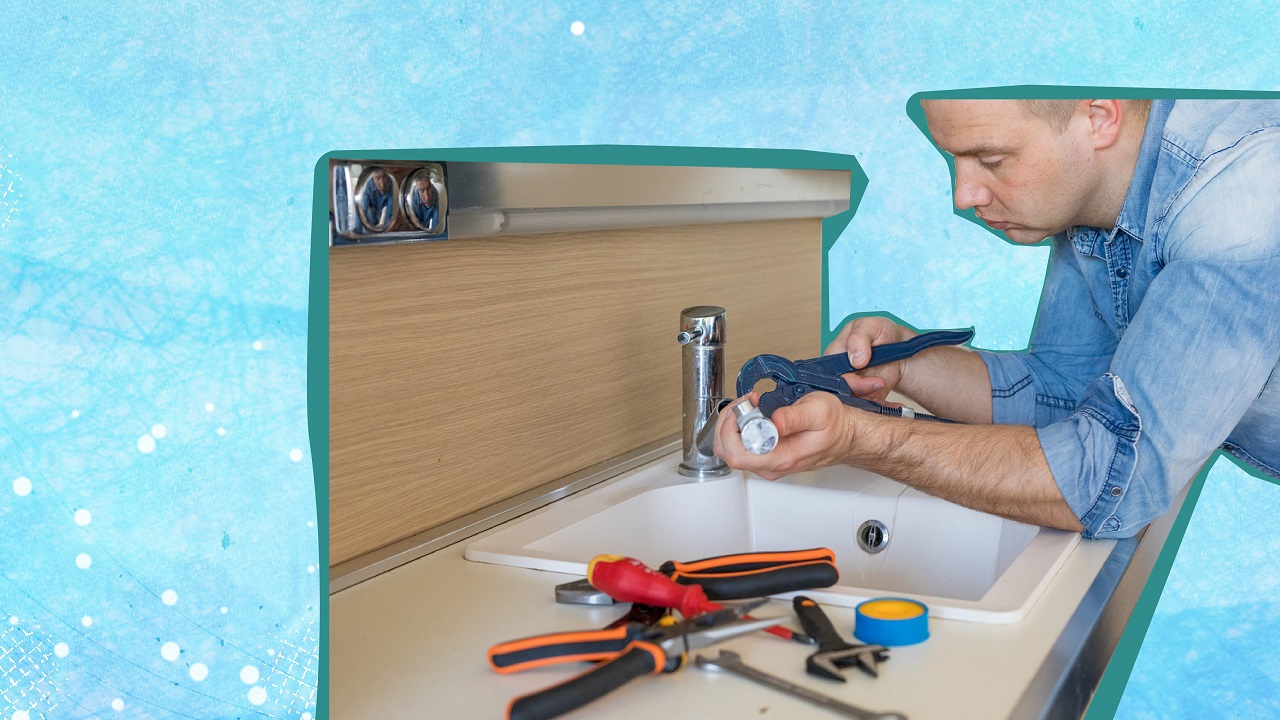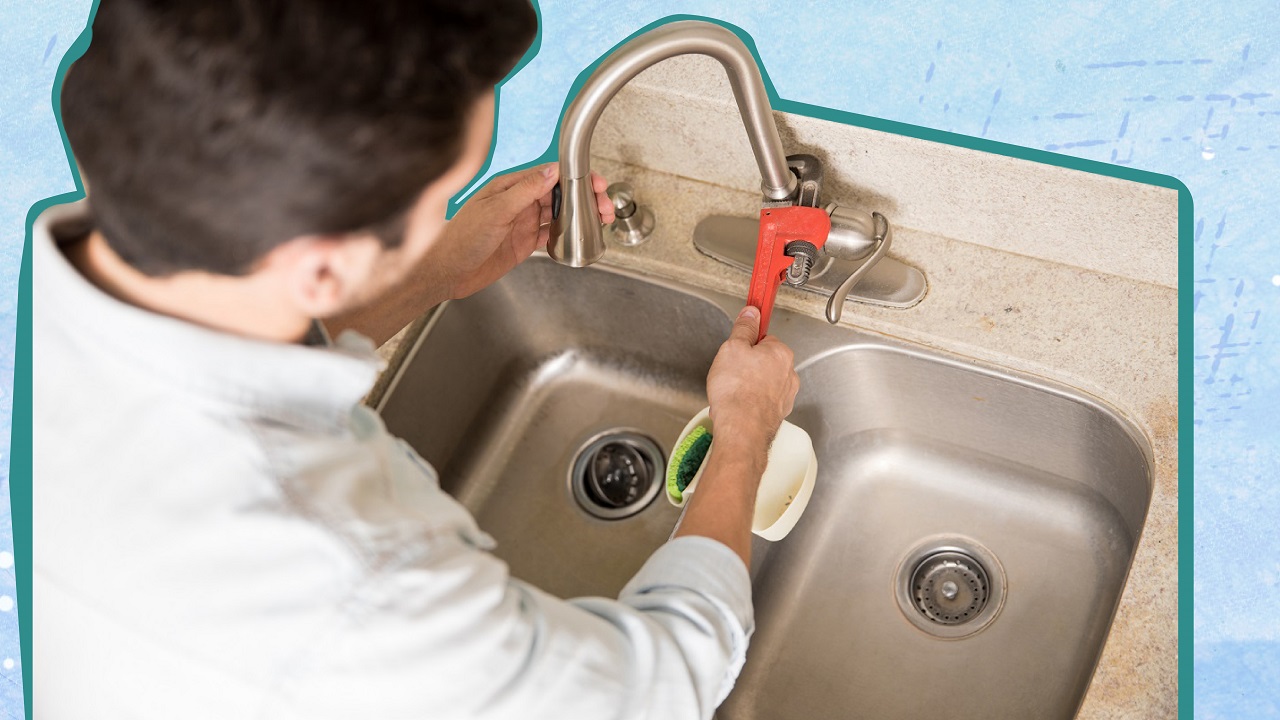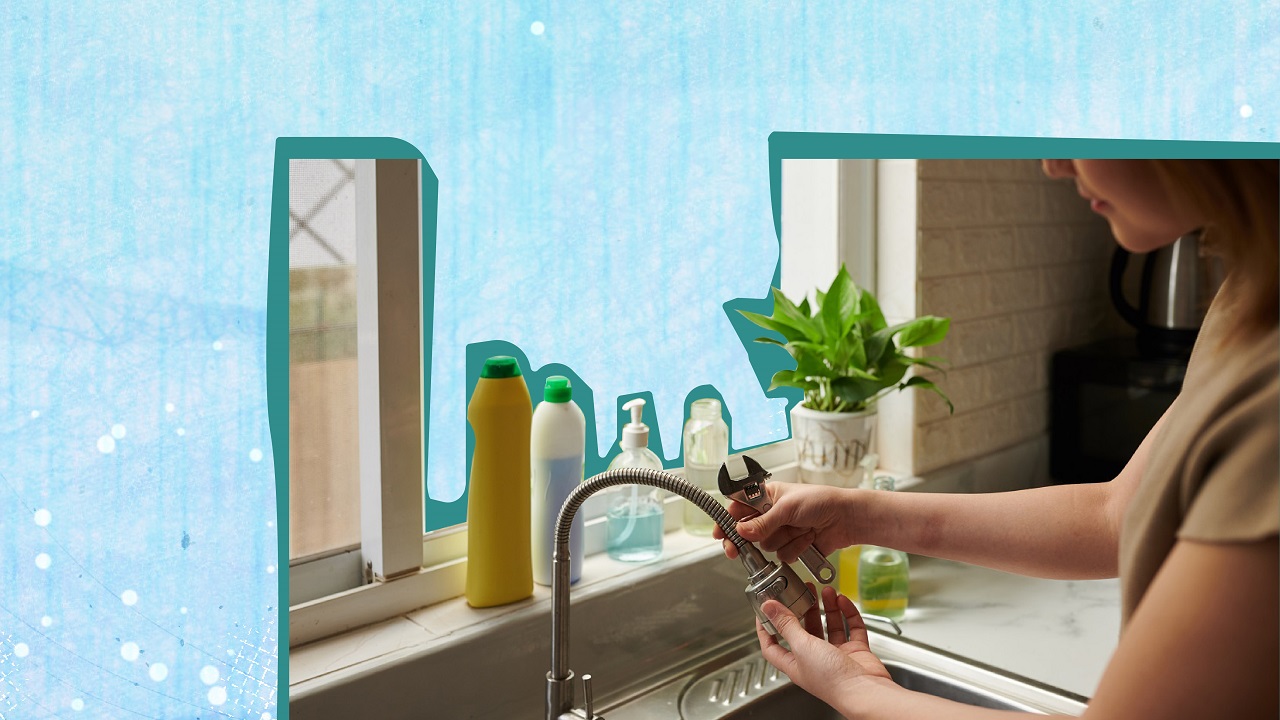It’s not difficult to identify a leaking faucet. The constant Plink. Plink. Plink. sound of the leaky faucet is enough to alert you. Or, simply use a thermal leak detection kit to ascertain if it’s really a leak that’s keeping you up all night.
In this detailed guide, we will walk you through the difference between a compression faucet and washerless faucet, the reasons behind a leaking faucet, and how you can detect such leaks. We have also included the steps to fix leaks based on the type of faucet.
Back To Basics: Compression Faucet Or Washerless Faucet

You can find either of the two kinds of faucets at home: compression faucet or cartridge faucet (washerless faucet). Since these two kinds of faucets utilize different types of components to control the water flow, the way they are to be fixed are also quite different from each other.
1. Compression Faucet
In a compression faucet, a rubber washer is used to keep the valve seat intact. But after regular use, the washer constantly rubs against the valve seat, causing friction. Eventually, the compression faucet will start leaking.
2. Cartridge Faucet (Washerless Faucet)
In a cartridge faucet, instead of rubber washers, a tiny ball or cartridge is used to keep the valve seat in place and control the water pressure. Though these taps are more durable than compression faucets, they can break and wear out in case of too much pressure.
3. Other Kinds Of Faucets
Apart from compression faucets and cartridge faucets, there are other kinds of faucets. These variations include ceramic disk faucet and ball faucets.
Why Do You Have A Leaky Faucet Or A Dripping Faucet?
Faucets can control the dripping water in two ways: using faucet cartridges or compression valves. The compression valves constantly close and open to control the water supply. And as we have mentioned above, leaking faucets result from a worn-out rubber washer or a faucet cartridge. As a result, when these parts of a sink faucet are fixed or replaced, the leaking faucets are also fixed.
1. Worn-Out Compression Faucets
In compression valve faucets (that are more common in older households), the water supply stops when the faucet handle is twisted. This compresses the stem washer present inside the faucet.
Due to regular use, the stem washer eventually wears out, and no matter how tightly you close the faucet, the water never stops dripping. In this case, one can replace the washer and quickly take care of the compression faucet leak.
Tip
The compression valve washers are available in an inexpensive kit that contains other screws and washers of different sizes. You should get this kit to easily find the perfect fit for your leaky faucet.
2. Worn-Out Sink Cartridge
A one and two-handle cartridge faucet has sink cartridges fitted under the faucet handles. These sink cartridges are mostly made up of metal or plastic. If they wear out due to regular use, you cannot fix them, but can easily replace the old cartridge with a new one.
Most of the sink cartridges are brand and size-specific. Thus, you’ll have to purchase the exact kind of cartridges for your bathroom and kitchen faucets from the store.
How To Detect A Water Leak
Leaking faucets can cause many problems if not identified on time. As such, every homeowner should know how to detect a water leak and fix it as soon as possible. We have listed a few ways through which you can detect a leaky faucet and find a suitable solution for it.
1. Use A Leak Detector
Some faucets and fixtures have a higher possibility of leaking than others. Therefore, installing a battery-operated detector would be a good decision as it would emit a shrill alarm whenever it senses a leak. You can then quickly fix the leak and prevent the faucet from causing more damage. One can also use a thermal leak detector to detect water leaks at home.
2. Keep A Check On The Water Bill
We all know the amount of water we use daily; thus, guessing the monthly water bill shouldn’t be a challenging task. If the water bill is more than what you had expected, then there are chances that the precious drops of water are getting wasted somewhere.
3. Keep Looking For Leaking Clues
The slow trickling of water is the worst form of water leakage because you will not notice this unless severe damage is caused. Dripping water can cause many problems: damp or musty smell, discoloration of walls, constant trickling sounds that can be annoying, and bubble walls.
4. Look Out For Green Grass Patches
If a particular patch of land is greener than the other areas, it might be a signal that a buried water line is constantly leaking. In case the water leak is extensive, then muddy puddles may also be seen in some parts of the land.
5. Check Out For Leaks From The Faucet Spout
Leaks from the spout can be detected when water constantly drips, even when the faucet handle is turned off. Either the faucet handle has to be shut more tightly, or it has to be adjusted in a position where the water doesn’t drip anymore.
How To Fix A Leaking Faucet

A. Turn Off The Water Connection To The Faucet
Before you think of how to fix a leaking sink cartridge, always remember to shut off the water connection to the faucet. All you have to do is turn off the tap that is just below the sink.
After doing this, try to find the two plaited water supply lines and the two water supply valves that connect to them. Then try to stop the water connection by twisting the knob in the clockwise direction until the water stops flowing through the faucet.
B. Equipment You’ll Need Before You Start Repairing
- A utility knife
- An Allen wrench
- A flathead screwdriver
- Adjustable pliers
- O-rings
- Plumber’s grease
- Stem nut and screws
Tip
You can easily find all the equipment mentioned above in a local store or online sites like Amazon.
C. How To Fix A Faucet Cartridge
Step 1:
Remove the decorative cap on the faucet handle, then carefully remove the handle screw, pull the handle back, and lift it.
Step 2:
If the cartridge is fixed with the help of a threaded retaining clip, you can use needle nose pliers to remove it and pry out the cartridge straight up.
Step 3:
The next step is to remove the spout and detach the o-ring with the help of a utility knife. Before fitting the new o-rings, do not forget to apply the plumber’s grease on them.
Step 4:
If you want to change the entire cartridge, then match the old cartridge with the new cartridge and compare their lengths. Don’t forget to check the stem ends where the handle is attached.
D. How To Fix A Compression Faucet
Step 1:
A compression faucet starts leaking because of a damaged seat washer. So, use a utility knife to remove the decorative cap of the faucet. This will give you access to the attachment screws. And with the help of a handle screw, take out the handle.
Step 2:
The next step is to unscrew the packing nut and carefully loosen the stem from the faucet body using an adjustable wrench. Then you need to remove the rubber washer from the bottom of the stem and change the seat washer. Before fixing the washer, use a plumber’s grease to protect it.
Step 3:
Remove the stem from the packing nut and change the o-ring. Don’t forget to match the size of the o-ring with your faucet and coat it with the plumber’s grease.
Step 4:
The washer is fitted inside a round, disk-like structure called a retainer. You should check if the retainer is damaged and replace it with a new one if needed. Even after all these steps, the faucets might leak if the seat washer is uneven.
Step 5:
Smoothen out the top of the seat with sandpaper; if you still can’t fix it, replace it with a new one.
When Should You Replace Instead Of Fixing Your Faucet
There are some cases where your faucet might need a replacement instead of a fix. We have explained such cases below.
1. If the Repairs Are No Longer Working
Faucets are in constant use in our households. Sometimes, even after fixing the faucet, water may keep dripping continuously. Even after turning off or adjusting the faucet handles, things don’t change. This signals that faucets don’t last forever and you need to replace your faucet immediately.
2. Faucet Is Too Old
If your faucet is older than fifteen or twenty years, then it wouldn’t be long before the entire system falls apart and water starts dripping incessantly. You should buy a replacement kit and change the faucet; that would be much cheaper and more convenient.
3. Repairs Are Too Expensive
Before you start the repair process, compare the cost of repairing and fixing the faucet. If the faucet is inexpensive, then it is wiser to replace it. If the faucet is too expensive and belongs to a particular brand, it is smarter to repair it if it’s possible that is.
4. Repairings Take A Long Time
A leaky faucet should take around 30 minutes to an hour to repair. However, if you’re spending more than the required hours fixing a leaky faucet, you should consider replacing it.
When Should You Call A Plumber?
Most faucets can be repaired without the professional help just by following a few simple steps. However, there are some cases where you might not be able to fix or replace the faucet on your own.
If the task is complicated, you can call plumbers for the job. They can also advise you on different technical matters of faucets that otherwise you may have not known.
Tip
You should remember that calling emergency plumbers might cost more than any fixes you can make at home easily. Weigh all the factors and make sure that you take the right decision.

How To Fix A Leaking Faucet Conclusion
Knowing the kind of faucet that is fitted in your kitchen and washroom is essential. This will help you diagnose the problem and quickly find a repair solution. That said, repairing your faucet may take some time, but the above-mentioned steps are easy to follow.
You should be able to identify if your leaking faucet needs a repair or should be replaced. Sometimes, even after fixing the faucet, the water keeps dripping, making your hard work go in vain. Therefore, you should replace your faucet immediately if the repairs aren’t working.
Further, several thermal devices on the market can help you detect water leaks. Install these devices to ensure that your faucet doesn’t waste much water. After all, fixing a leaking faucet is not just a mechanical aspect; it shows that you’re also taking a conscious step towards building a sustainable future.


